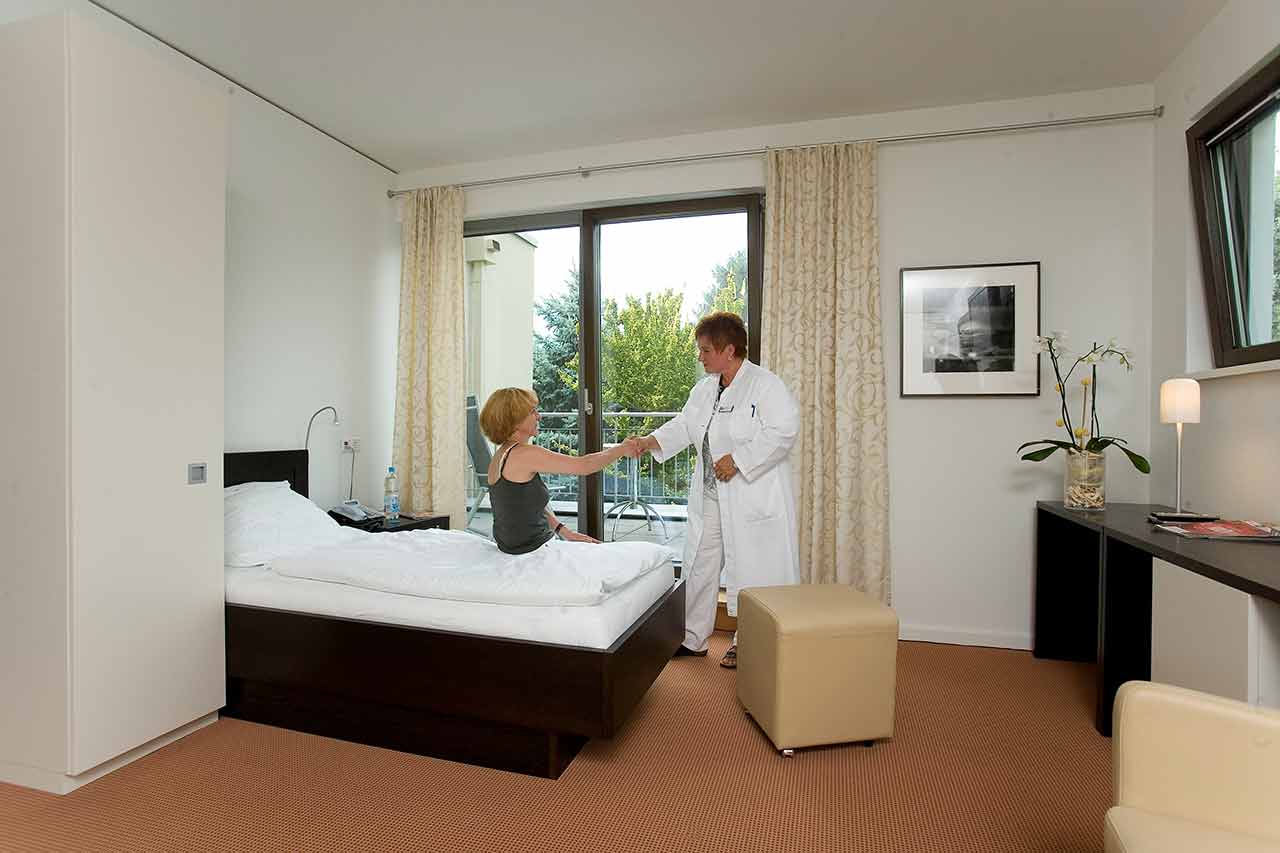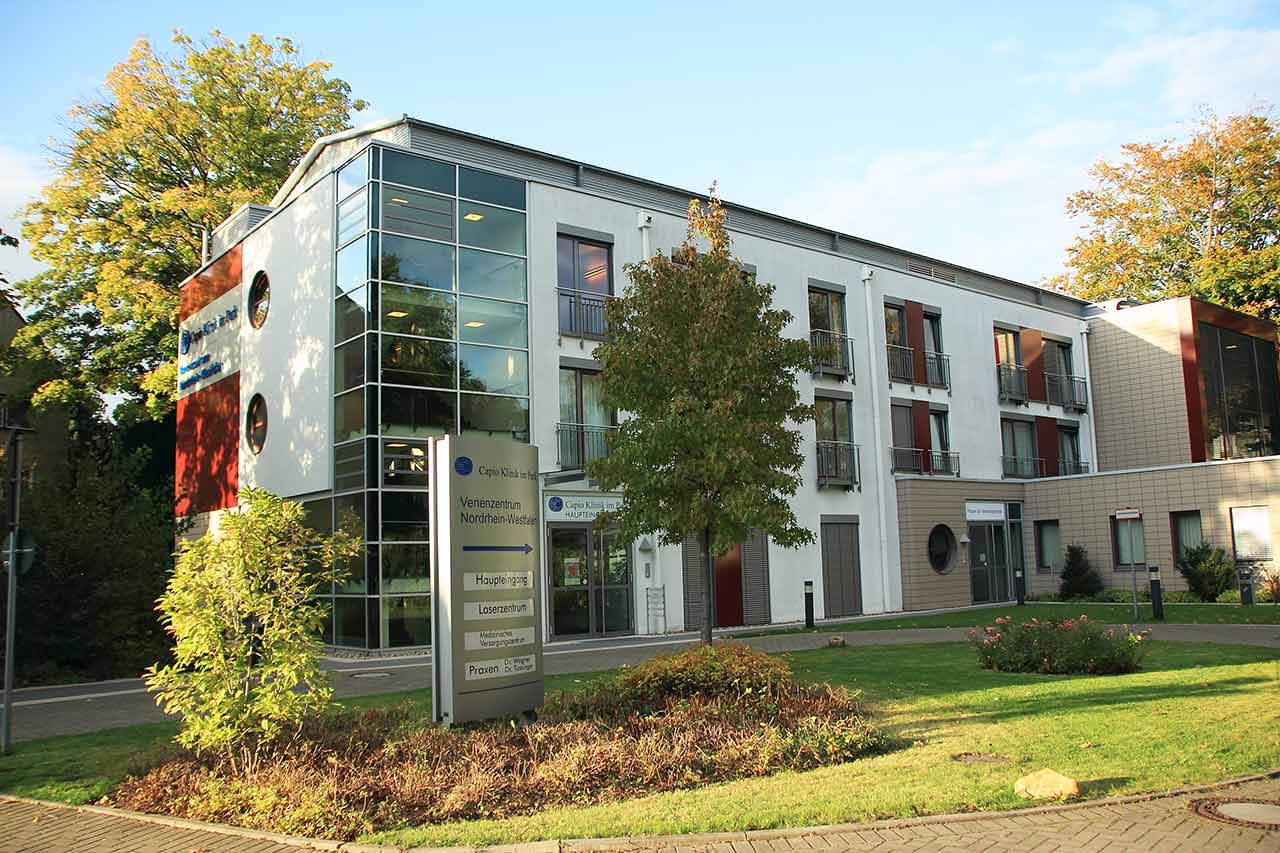
The program includes:
- Initial presentation in the clinic
- clinical history taking
- review of medical records
- physical examination
- dermatological examination
- laboratory tests:
- complete blood count
- biochemical blood analysis
- inflammation indicators (CRP, ESR)
- indicators of blood coagulation
- venous doppler ultrasound
- lymphangiography
- fluorescence microlymphography
- lymphoscintigraphy (on indication 1200 €)
- CT (on indication 650 €)
- MRI (on indication 1200 €)
- consultation of all leading expert
- nursing services
- development of individual treatment plan
- written statement
Required documents
- Medical records
- Photo of the affected body regions
Service
You may also book:
 BookingHealth Price from:
BookingHealth Price from:
About the department
The Department of Phlebology at the Bergman Clinic im Park for Innovational Phlebology Hilden provides the full range of medical services in the field of its competence. The department's team of doctors provides highly accurate diagnosis and effective treatment of venous diseases, with a special focus on helping patients with varicose veins, lymphedema, lipedema, and trophic ulcers of the lower extremities (ulcus cruris). The department's specialists have all the necessary technical resources to examine the venous system and detect the slightest pathological changes. The treatment involves the use of the very latest laser procedures and minimally invasive surgical interventions. When the department's doctors detect venous pathology in its early stages, they often use only conservative therapy. The department admits more than 20,000 patients with clinical cases of varying severity annually and sees an increasing number of patients each year. The medical facility is certified as the Competence Center for Venous Diseases, which provides each patient with high-quality treatment of the European standard. The department is headed by Dr. med. Elisabeth Langer.
The most common disease in the department's clinical practice is varicose veins. The condition causes the pathologic enlargement of superficial veins in the lower extremities. Many people mistakenly believe that varicose veins are only an aesthetic problem. However, without treatment, the disease may lead to the development of severe complications such as deep vein thrombosis, pulmonary embolism, eczema, or trophic ulcers on the legs. The primary diagnostic method for confirming the diagnosis is ultrasound scanning. Taking into account the stage of the pathology, the department's doctors elaborate an individual treatment regimen for each patient.
The department uses both conservative and surgical treatment methods for varicose veins. Conservative therapy includes wearing compression stockings, physiotherapeutic procedures, lymphatic drainage, and naturopathy. If the attending physician finds the advanced stage of varicose veins, minimally invasive surgical intervention is mostly required. Varicose vein surgery is performed under local anesthesia and on an outpatient basis whenever possible. The specialists of the medical facility have at their command all the advanced surgical techniques for removing varicose veins: stripping, crossectomy, extraluminal valvuloplasty, ligation, and phlebectomy. The department's doctors also brilliantly perform radiofrequency ablation for varicose veins and endovenous laser coagulation.
The department's range of services includes the innovative CHIVA procedure. The method involves modeling venous blood flow instead of removing the affected vein. The CHIVA procedure is highly effective and allows for the avoidance of trauma to the adjacent lymphatic vessels, nerve endings, and subcutaneous tissue. The therapeutic manipulation is performed under local anesthesia on an outpatient basis. Clinical trials confirm that the risk of disease recurrence after the CHIVA procedure is negligible.
The department's doctors also specialize in the treatment of lymphedema. Patients with this disease have a gradual increase in limb volume due to impaired lymphatic outflow and its accumulation in the intercellular space. A clinical examination is usually sufficient for diagnosis, although imaging tests (ultrasound, CT, or MRI) may also sometimes be required. The best results in the treatment of lymphedema can be achieved by a combination of physiotherapy, lymphatic drainage, and compression therapy.
The medical facility admits many patients with lymphedema. The disease occurs only in women and is characterized by the abnormal distribution of adipose tissue in the thighs and buttocks. Palpation of adipose tissue deposits causes severe pain in women. During the diagnosis, the attending physician carries out a thorough examination, often additionally performing an ultrasound scan of adipose tissue deposits on the lower extremities. The most effective methods in the fight against lipedema include manual lymphatic drainage and compression therapy. If conservative treatment fails, the specialists resort to liposuction, a surgical procedure for removing adipose tissue deposits.
The department's diagnostic options include the following:
- Light reflection rheography (LRR)
- Venous occlusion plethysmography (VOP)
- Vascular deformation mapping (VDM)
- Color-coded duplex sonography
- Doppler ultrasound scanning
- Other diagnostic procedures
The department's therapeutic options include the following:
- Treatment of varicose veins, starburst varices, and spider veins
- Conservative treatment methods
- Compression therapy
- Manual lymphatic drainage
- Physiotherapeutic procedures
- Classical sclerotherapy and ultrasound-guided foam sclerotherapy
- Laser removal of spider veins with a diode laser
- Surgical treatment methods
- Stripping
- Crossectomy
- Extraluminal valvuloplasty
- Ligation
- Phlebectomy
- CHIVA procedure (innovative treatment method)
- Endoluminal laser therapy
- Radio frequency therapy
- Conservative treatment methods
- Treatment of lymphedema
- Physiotherapy
- Lymphatic drainage
- Compression therapy
- Treatment of lipedema
- Manual lymphatic drainage
- Compression therapy
- Treatment of venous ulcers
- Conservative treatment methods
- Compression therapy
- Physiotherapy
- Surgical treatment methods
- Split-skin grafting (autodermoplasty)
- Conservative treatment methods
- Treatment of other venous diseases
Photo of the doctor: (c) Bergman Clinics Klinik im Park
About hospital
The Bergman Clinic im Park for Innovational Phlebology Hilden enjoys a reputation as one of the most competent medical facilities in Germany, specializing in the treatment of venous diseases. The clinic first opened its doors to patients in 1984. Over time, an advanced Laser Therapy Center was also established here. The team of highly qualified doctors treats more than 20,000 patients annually, including those from abroad. The clinic successfully performs more than 6,000 surgical interventions on patients with such pathologies as varicose veins, deep vein thrombosis, and phlebitis.
The treatment rooms and operating suites in the clinic have state-of-the-art medical equipment, which allows for performing both routine and particularly complex therapeutic procedures with excellent results.
The clinic employs an experienced team of phlebologists and nursing staff who are dedicated to providing each patient with personalized care in accordance with modern medical standards. The doctors listen attentively to the wishes of their patients and strive to fulfill them, if possible.
The clinic was granted the prestigious DIN EN ISO 9001:2015 certificate. In addition, the clinic is certified by the German Society of Phlebology (DGP) and the Professional Association of German Phlebologists as the Competence Center for Venous Diseases. The certification attests to the top-class medical service and high treatment success rates.
The Bergman Clinic im Park for Innovational Phlebology Hilden consists of two complexes: a modern new building and a charming old villa, which are connected by a magnificent park with rhododendrons. During their free time between medical procedures, patients can walk in the picturesque park and take their minds off the therapeutic process.
Photo: (с) Bergman Clinics Klinik im Park
Accommodation in hospital
Patients rooms
The patients of the Bergman Clinic im Park for Innovational Phlebology Hilden live in comfortable single and double rooms. The rooms are furnished to the level of a top-class hotel and offer a magnificent view of the park. The patient room furnishings include a comfortable bed, a bedside table, a wardrobe, a flat-screen TV, a telephone, a safe, a minibar, and a cozy corner with upholstered furniture for rest. Wi-Fi access is available in every room. Each patient room has an ensuite bathroom with a shower and a toilet. The bathroom also has toiletries, changeable towels, a bathrobe, and a hairdryer.
Meals and Menus
The patients of the clinic are offered three tasty meals a day: breakfast and dinner are served buffet-style, while lunch offers several set menus for patients to choose from. The menu regularly features dietary and vegetarian dishes. An individualized menu can also be offered to the patient, if necessary.
Further details
Standard rooms include:
Accompanying person
Your accompanying person may stay with you in your patient room or at the hotel of your choice during the inpatient program.
Hotel
You may stay at the hotel of your choice during the outpatient program. Our managers will support you for selecting the best option.









